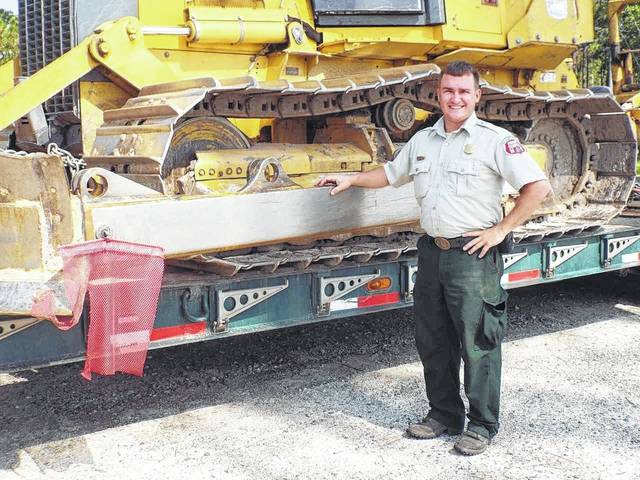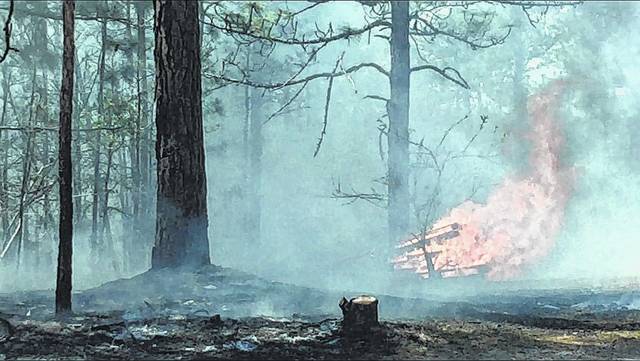For seven years, Richmond County has held the dubious distinction of being No. 1 in the state for wildfires.
It held on to the title in the fiscal year just closed June 30, logging 195 fires. On one particularly hectic day, the Forest Service office in Hamlet received nine fire calls in the course of 45 minutes.
“Richmond County’s burned up every year,” County Ranger Matt Gordon said Tuesday. “It just does.”
Gordon hopes against hope that people will start paying attention to the county’s burn ordinance, which restricts fires to at least 1,000 feet from a dwelling. The ordinance also prohibits the burning of items to organic matter — “so, basically, if it didn’t grow on your property, you’re not allowed to burn it.”
He wishes people wouldn’t burn organic matter either, when they can just dump it at a county transfer station.
“(But people would) just as soon burn their trash” than haul it to a convenience station for free disposal, Gordon said. “I guess they just feel it’s out of their way.”
Sometimes, he said, the reason’s heredity: My grandpa burned his trash. My daddy burned his. So I burn mine.
And sometimes, such burns spark wildfires.
A wildfire is any fire burning uncontained in woodlands, grasslands or bushlands that humans must extinguish, Gordon said. For the N.C. Forest Service, such a fire might force rangers to bulldoze a fire trench to head off a big blaze or work with local fire departments to prevent damage to homes and other property.
Fires range from “little fires on the side of the road” to wildfires raging over 300 or more acres.
Richmond County’s largest fire this past fiscal year burned 374 acres.
The grand total of acreage burned? 1,196 — an average of slightly more than 6 acres per fire.
Most fires occurred in the eastern part of the county, which boasts sandy soil, longleaf pines and grassland. But since trees cover 80 percent of Richmond County, the tinder for a big fire is almost everywhere.
The biggest fire last year started with an unattended campfire off Derby Road near Hoffman, Gordon said. It took three bulldozers and helicopters dropping water to contain it.
“It almost burned down … four houses and eight horse barns,” he said.
No culprit ever was pinpointed, though Gordon has his theories.
Human error — or human endeavor — causes most fires, Gordon said. Richmond County experiences a high number of lightning strikes, but only five wildfires could be attributed to them in fiscal 2016-17.
⦁ Two campfires started burns of 374 and 197 acres.
⦁ Children caused only seven fires, burning less than 3 acres. Kids generally tell on themselves as soon as they see a problem, Gordon said. So their fires remain small.
⦁ Seven winter wildfires resulted from the dumping of ashes.
⦁ Arson accounted for fewer than 50 fires. The figure is fuzzy because arson is difficult to pin down.
⦁ About 80 wildfires resulted from debris burns that went out of control.
Downed power lines usually account for eight to 10 wildfires yearly.
“Every fire starts small and builds upon itself,” Gordon said. Afternoon is peak burning time because it is so hot and, often, windy — two conditions that promote the spread of fire.
“(Fire) can actually take off and get into the tops of the trees, (but) it’s got to have something to get it from the bottom to the top,” Gordon said. That can be undergrowth providing things for the fire to climb, or wind — or swamp gases. Those, Gordon said, burn like gasoline and likely promote many wildfires.
Last year, Gordon issued 71 tickets for burn violations — fires that went out of control — as well as two citations for repeat violations. The latter tends to put people off burning, he said, because they must pay fines plus court costs of $180.
County environmental officers will enforce new restrictions on burning inorganic material, which can release harmful substances into the air.
Reach Christine Carroll at 910-817-2673.


